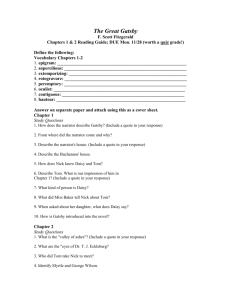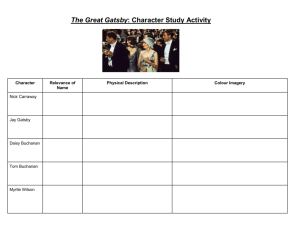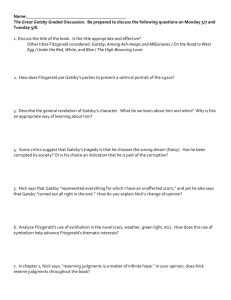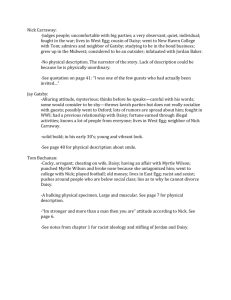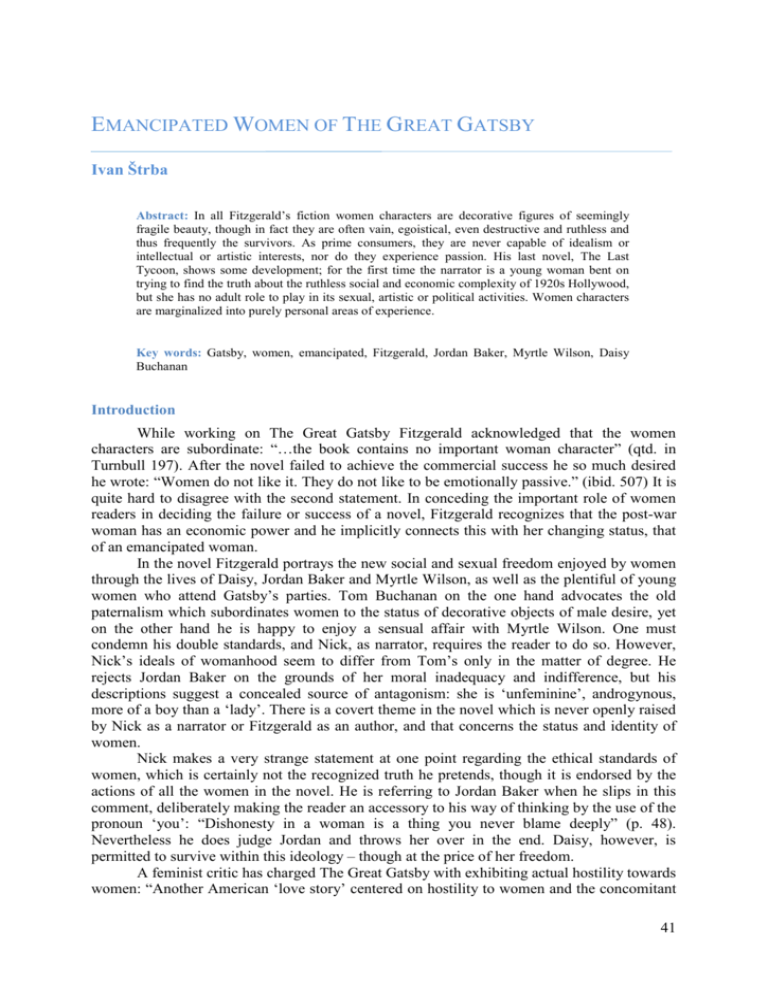
EMANCIPATED WOMEN OF THE GREAT GATSBY
Ivan Štrba
Abstract: In all Fitzgerald’s fiction women characters are decorative figures of seemingly
fragile beauty, though in fact they are often vain, egoistical, even destructive and ruthless and
thus frequently the survivors. As prime consumers, they are never capable of idealism or
intellectual or artistic interests, nor do they experience passion. His last novel, The Last
Tycoon, shows some development; for the first time the narrator is a young woman bent on
trying to find the truth about the ruthless social and economic complexity of 1920s Hollywood,
but she has no adult role to play in its sexual, artistic or political activities. Women characters
are marginalized into purely personal areas of experience.
Key words: Gatsby, women, emancipated, Fitzgerald, Jordan Baker, Myrtle Wilson, Daisy
Buchanan
Introduction
While working on The Great Gatsby Fitzgerald acknowledged that the women
characters are subordinate: “…the book contains no important woman character” (qtd. in
Turnbull 197). After the novel failed to achieve the commercial success he so much desired
he wrote: “Women do not like it. They do not like to be emotionally passive.” (ibid. 507) It is
quite hard to disagree with the second statement. In conceding the important role of women
readers in deciding the failure or success of a novel, Fitzgerald recognizes that the post-war
woman has an economic power and he implicitly connects this with her changing status, that
of an emancipated woman.
In the novel Fitzgerald portrays the new social and sexual freedom enjoyed by women
through the lives of Daisy, Jordan Baker and Myrtle Wilson, as well as the plentiful of young
women who attend Gatsby’s parties. Tom Buchanan on the one hand advocates the old
paternalism which subordinates women to the status of decorative objects of male desire, yet
on the other hand he is happy to enjoy a sensual affair with Myrtle Wilson. One must
condemn his double standards, and Nick, as narrator, requires the reader to do so. However,
Nick’s ideals of womanhood seem to differ from Tom’s only in the matter of degree. He
rejects Jordan Baker on the grounds of her moral inadequacy and indifference, but his
descriptions suggest a concealed source of antagonism: she is ‘unfeminine’, androgynous,
more of a boy than a ‘lady’. There is a covert theme in the novel which is never openly raised
by Nick as a narrator or Fitzgerald as an author, and that concerns the status and identity of
women.
Nick makes a very strange statement at one point regarding the ethical standards of
women, which is certainly not the recognized truth he pretends, though it is endorsed by the
actions of all the women in the novel. He is referring to Jordan Baker when he slips in this
comment, deliberately making the reader an accessory to his way of thinking by the use of the
pronoun ‘you’: “Dishonesty in a woman is a thing you never blame deeply” (p. 48).
Nevertheless he does judge Jordan and throws her over in the end. Daisy, however, is
permitted to survive within this ideology – though at the price of her freedom.
A feminist critic has charged The Great Gatsby with exhibiting actual hostility towards
women: “Another American ‘love story’ centered on hostility to women and the concomitant
41
strategy of the scapegoat… Not dead Gatsby but surviving Daisy is the object of the novel’s
hostility and its scapegoat.” (Fetterley 72) Hostility is a serious charge. While Nick’s
seemingly casual comment which I have just quoted expresses a patronizing contempt for
women’s ethical capacities, it could be also interpreted as a manifestation of his own
immaturity which Fitzgerald intended the reader to recognize. 8 More seriously, there is not a
single female character who exhibits anything but a desire for a good time and material
possessions. No woman character in the novel understands or cares about either Nick’s moral
preoccupations and his desire to understand experience or Gatsby’s intense devotion to a
dream which transcends his circumscribed self. Admittedly, this is a satirical novel and none
of the other male characters pretends an interest in an inner life either, and of course Nick and
Gatsby dominate this concern of narrative. It is true to say that any interest other than a
preoccupation with their own needs is beyond the women characters. Daisy’s ethereal beauty
requires the connivance and protection of men to maintain in at whatever cost to her moral
identity, and Tom, Gatsby and Nick are all accomplices to this. There is no single scapegoat,
as Fatterley suggested. All the characters contribute to the crash and decay of the humanity
within self, either by wilful means of their choices (Tom, Daisy, Jordan) or by unconscious
nurturing of the hideous ego and lack of sound ‘admonitory’ voice towards its victims (Nick),
or simply by unawareness of the disintegration human morality (Gatsby).
At the first party nick notices a number of ‘unaccompanied’ girls. They are an
important feature of the swirling hedonistic crowds who come to Gatsby’s house, swimming
with the social tide, unconcerned about the sources of Gatsby’s wealth. When the ‘Jazz
History of the World’ is over, “girls were putting their heads on men’s shoulders in a
puppyish, convivial way, girls were swooning backwards playfully into men’s arms, even into
groups, knowing that someone would arrest their falls” (p. 41). They are emancipated yet they
depend upon men. Many of them seem to belong to the world of Broadway and they
contribute their share of the vulgarity which appals Daisy. On the contrary, wives seem to
belong to the more stable world of East Egg, though the freedom and spontaneity of Gatsby’s
parties put a strain on their marriages.
The men constitute ‘the world’; the women are merely ‘its mistress’. The girls’ words
convey an equal lack of concern about Gatsby and the horrific recent war. The rumours about
Gatsby are clearly ludicrous, but it is all a matter of indifference to them whether this is so or
not. They are shown up more coldly in the morning than in the moonlight, and the reference
to a rose is echoed in Nick’s reconstruction of Gatsby’s last moments, when he “found what a
grotesque thing a rose is” (p. 128). The girls’ connection with the fragile offerings of Gatsby’s
garden, a rose or a crystal glass, intensifies their callousness. These are nameless young
women who fit through the narrative as emancipated girls of the Jazz Age, but their new
freedom merely makes blatant their complete lack of ethical concern.
When Daisy Buchanan begs “Oh, let’s have fun” (p. 95), she is expressing what all
these young women desire. For young Daisy (Fay) the war was a time when nice young girls
rolled bandages for the Red Cross and had a good time with the officers, while the red, white
and blue flags flew from their homes in patriotic display, disapprovingly ‘tut-tutting’ at the
flirtatious freedom now enjoyed by ‘nice’ girls. Their artificial world enables them to think of
nothing else but affairs of caprice and heart. The girls at the Gatsby’s parties have no social
status to consider, they just want to have a good time in the frenetic scene of the early 1920s.
All the young girls, and the young Daisy Fay too, are portrayed as the centre of sexual
interest. It is they who contribute the erotic interest in the novel, not the men. The accounts of
8
Nick relationship and perception of Jordan develops as the novel unfolds. He blames her while absolving her
because she is a woman. It is never an easy relationship, nor is it an appealing one. Nick does not quite know
how to handle this cool, poised, independent woman of the 1920s who lays down the terms of the relationship
and manipulates them to her advantage.
42
music, dancing or gaiety which help to create the pervasive mood of luminous but evanescent
beauty draw attention to their youth and allure. At the parties it is the girls who “glide on
through the sea-change of faces and voices and colour under the constantly changing light.”
(p. 34) The girls may be ‘gold-diggers’ 9, strident and comically vulgar, but Fitzgerald makes
their sexual vitality the focus of these scenes.
In the following lines I will try to demonstrate and emphasize the harrowed inner
world of few main female protagonists, since they bear the very flag of their moral decadence
on their shoulders, yet its quality holds miscellaneous nuances due to the nature of their
origins.
Myrtle Wilson
She is introduced into the novel by her telephone call, which disturbs the urbane
surface of Daisy’s dinner party, bringing tensions between husband and wife into the open.
Her social class is implied by Jordan Baker’s critical remark, “Tom’s got some woman in
New York”, who hasn’t “the decency no to disturb at dinner” (p. 16).
Fitzgerald has very cleverly inserted the presence of this shrill insistent intruder into
the Buchanan’s opulent world, which is insulated from heat, wind and everything unpleasant.
Myrtle represents overt, unconcealed sexuality. Her flower name suggests a fleshy yet
beautiful climbing plant vigorously moving upwards, but she is not allowed to realize her
impossible dream. Her fleshiness is voluptuous, and she emphasizes this by wearing her dress
stretched tight over her broad hips. By grammar and speech, as well as taste, Myrtle is
distinguished from Tom Buchanan’s exclusive world. Her manner is rather sharp and
affectations are almost comic. Yet despite her affectations and her ambition to move up in the
world, she is not ludicrous. Her vitality is evident, as she dominates the people she is exposed
to interaction with in the novel. The language she uses is energetic, direct and unselfconscious
about her own sexual needs. Her lower-class pretensions appear comical to Nick because he
judges them form a position of social superiority, but her overt sexuality impresses him. She
desires Tom because of his bulky masculinity and his social style, and in a way her sexuality
is a counterpart of Gatsby’s romantic passion for Daisy. No other character in the novel
expresses such urgency of desire as when she, for instance, she mentions the first time when
she saw Tom: “All I kept thinking about, over and over, was ‘You can’t live forever; you
can’t live forever’” (p. 31). Myrtle is a voluptuous and sultry woman, though the vitality and
liveliness of her personality is demonstrated even when being confronted with her husband in
the garage, shouting “‘Beat me!’ he heard her cry. ‘Throw me down and beat me, you dirty
little coward!’” (p. 109) There is venom in the way she addresses her husband and the idea of
Wilson beating her is simply ridiculous; she is venting her anger and desperation of a
frustrated woman when her fantasy/dream is being destroyed.
The moment of her death is both dramatized and given added significance by the
language, as “her life violently extinguished, [she] knelt in the road and mingled her thick
dark blood with the dust” and her body is “wrapped in a blanket, and then in another blanket,
as though she suffered from a chill in the hot night” (p. 109-110). There is irony in her
kneeling, a posture usually associated with prayer or penitence, and so the narrative style
suggests that she is paying a heavy price for her adulterous sexual life. The usage of
monosyllables and the alliteration of ‘thick dark blood’ and ‘dust’ emphasize this. It is also
the horrific details of Myrtle’s injuries that carry implications which are also related to her
9
‘Gold-digger’ was once a favourite metaphor for a woman who exploited her sexuality to get money out of
men. Blatant transformation of ‘love’ into money is exchanged with girls’ exploitation of their sexuality for a
good time at the Gatsby’s parties. More subtle aspects of the relationship between love and money are present
in the case of Daisy’s marriage, Gatsby’s love for Daisy and even Nick’s affair with Jordan.
43
sexuality: “her left breast was swinging loose like a flap” and “the mouth was wide open and
ripped a little at the corners” (p. 109).
Although, to some extent, being paid tribute for her sexuality, nonetheless it seems
that Fitzgerald in the end makes Myrtle pay heavily for being openly sensualist. Tom certainly
does not pay for his sexual transgressions. Myrtle Wilson could never become anything more
but Tom’s ‘woman’, since her social status is simply unworthy of any more profound
engagement. Suggestion that they ought to “get married to each other right away” (p. 29) is
obviously a fantasy. However, Myrtle, being aware of this as much as of her sexual
attractiveness for Tom, constantly attempts to lure Tom into her womb and thus somehow
balance the unevenness of the scale of life. She takes what she can, even though she realizes it
is only what the divine world above can give without loosing its grandeur and loftiness. Dead,
Myrtle Wilson is a victim of the callous rich who hold the social and economic power as
much as she is a victim of her own corruptness evinced in her unachievable personal goal.
The human tragedy of the novel, as in real life, lies within its characters, rather than world
itself. American Dream is corrupted for both, the rich and the less rich, since it is not only
nobility that rots on the inside but also the lower class that deteriorates in attempt to attain the
heights beyond sight/immense.
Jordan Baker
Unlike Myrtle, Jordan Baker maintains a deliberate detachment which masks a
determination to come out on the top. Occupying a secure place in a socially influential
stratum, she manipulates a patriarchal world to her own advantage. Shift in the language and
style of writing that Fitzgerald uses enables the reader to sense the difference in both goals
and ways how to achieve those. While Myrtle, as a lower-class woman, talks without
restraint, Jordan rules her life by discretion. In any case, Fitzgerald offers no access to her
inner world, which in interpreted for the reader by Nick.
Jordan’s name associates her with cars, the Jordan sports car and the Baker 10. Fetterley
loosely suggests that the River Jordan, traditionally associated with the life of the spirit is, if
anything, contrasted with her existence. (72) Throughout the course of the novel it is Nick
who stresses that she is a very modern emancipated woman: her slenderness, the way she
holds herself, and the tan gained from her sporting life are emphasized several times. She, too,
as an independent young woman, wonders Gatsby’s gardens during the parties alone and even
wears her evening dresses like sports clothes, and there is an implication that she has lost her
femininity: she is androgynous.
Jordan is characterized by her rapid, deft movements “as if she had first learned to
walk upon golf courses on clean, crisp mornings” (p. 42), yet there is a stillness about her on
occasions: “She was extended full length at her end of the divan, completely motionless, and
with her chin raised a little, as if she were balancing something on it which was quite likely to
fall.” (p. 10)
Her complete ‘self-sufficiency’, demonstrated by her distancing from any emotional
entanglement, creates an effective contrast in the novel with Daisy’s ‘bright and passionate
mouth’ and the inner excitement she conveys; her boredom and contempt also contrasts with
Daisy’s radiance. On occasions, however, the two women seem to act in collusion. Their cool
social manner and ‘poise’ seem designed to make Nick feel socially clumsy or gauche.
Jordan’s composure and self-sufficiency express her determined “absence of all desire” (p.
10
Bruccoli in his Apparatus for F. Scott Fitzgerald’s The Great Gatsby puts it as “… the sporty Jordan and the
conservative Baker electric” which might be taken as the modern, emancipated woman who is determined to
enjoy the freedom and preserve the advantages of the ‘lady’. (1974: 122)
44
13); she has her sexuality and her emotions well under control and will not give way to
impulse.
Nick finds her sexually attractive but morally suspect, as he decides that is incurably
dishonest, since she would do anything, even lie or cheat in order to maintain the power
(advantage over others) that her personality desires. Jordan has achieved sexual freedom by
means of lying or concealment. Nick also judges that she avoids relationships with clever men
who might see through her, preferring instead the company of men who would never imagine
a woman – that is, a lady – breaking the codes of her class. Their conversation about careless
driving is precisely about personal ethics in any relationship. Jordan desires both the
traditional protection offered to a lady and the emancipation of the modern woman. She wants
the best of both worlds. Nick’s strong awareness of her lack of ethical concern puts into
question the basis of his own relationship with women: he acquits them of it because they
have no moral nature – “I was casually sorry and then I forgot.” (p. 48)
The crucial (turning) point in Nick’s relationship with Jordan is when she invites him
for supper after Myrtle’s death. He regards the invitation as a callous act, saying “I’d be
damned if I’d go in, I’d had enough of all of them for one day, and suddenly that included
Jordan too. She must have seen something of this in my expression, for she turned abruptly
away and ran up the porch steps into the house.” (p. 113) From this point Nick identifies with
Gatsby’s romantic passion rather than Jordan’s opportunistic form of realism. As neither
Jordan nor Daisy is allowed to reveal her inner feelings, the implication is that these frivolous
upper-class women have none. He thus makes a clean break with Jordan, even though he is
still “angry, and half in love with her, and tremendously sorry” (p. 141).
Fitzgerald’s characterization of Jordan Baker is achieved with clarity and detachment.
In essence it is hostile to her as a ‘new woman’, who claims all the advantages of an
emancipated lifestyle yet will use any strategies or duplicities to retain the traditional
advantages accorded to a ‘lady’. He seems to be implying that women’s status and sexual
image is at a point of crisis in the post-war world. Nick simply does not know quite how to
handle this cool, balanced, independent woman of the 1920s who lays down the terms of the
relationship and manipulates them to her advantage.
Daisy Buchanan
Jordan’s status in the narrative is never quite clear, other than as a foil and contrast to
‘sophisticated’ Daisy. It is Daisy’s voice, “a deathless song” (p. 76) that promises exciting
times to come and hints at exciting moments just past: it is just like Gatsby’s dream of her,
which contains no present reality, only past and future ecstasies. Fitzgerald informs the reader
too often of her charm without providing her with substance as a thinking, sentient woman.
The effect is to reduce her to a charming wraith, a being who exists only as a fragile veneer, a
shinning radiance of Gatsby’s construction, the centerpiece of Tom’s wealth, rather than a
woman with a personality of her own. Fitzgerald allows Daisy to exist only in the images men
create of her.
Daisy is torn between her responses to Gatsby’s romantic vision of herself and Tom’s
materialistic evaluation of her. Traditionally, the romantic imagination concerns itself with
constructing a world of possibility rather than with reality, but the emotion it generates is
often a sense of loss, for the transfiguring moment immediately becomes the past, the vision
cannot be sustained. Throughout most of the novel all the major motifs created by imagery of
summer, flowers, moon, stars, sunshine and birdsong cohere around Gatsby’s dream of Daisy,
the idealized girl, but contrary images of gold, money and cars also identify her. Gatsby clings
to his idealized vision of her, refusing to acknowledge to himself or Nick that she has
45
excluded him from her world, retreated once again into “the wealth that imprisons and
preserves safe and proud above the hot struggles of the poor.” (p. 119)
Daisy’s own sexual needs are not mentioned in Gatsby’s account any more than in
Tom’s perception of their relationship. She is perceived as passive, her sexuality sublimated
into her voice, which is made to represent the full impact of her female personality as well as
her femininity and charm. Her voice is the product of her environment, education and
upbringing. Her beauty and charm have a haunting quality: as a feature of Tom’s solidly
material world she is not a particularly interesting woman, and Fitzgerald fails to develop her
other than as a spoilt, petulant appendage of Tom. All of upper-class women in the novel are
presented as socially brilliant creatures who are morally and economically passive in a world
which has no other role for them. Fitzgerald asserts through Nick that they are sexually
exciting but he does not manage to make them sexually interesting.
Conclusion
All three women make an effort to move outside the social conventions of their class
and all three suffer for it: Myrtle Wilson is ripped open and destroyed; Jordan Baker seems to
have lost not only her integrity but her femininity too (an androgynous being); Daisy is
tempted three times to break out, but each time is easily dissuaded, and returns to her captive
position, retaining it finally through the collusion of Gatsby and Nick, who do not reveal that
she was driving the car that night but was unable to control the powerful vehicle.
The evidence of the novel suggests that Fitzgerald was fully aware of changes in
women’s role, and particularly in the status of the ‘lady’, in the post-war period, but viewed
them with mixed feelings. There is an aggression in Jordan Baker, the emancipated woman,
which constitutes a threat to Nick. Daisy is too much in love with her wealth and exclusive
position to make a real attempt to assert her freedom, preferring the privileges of the safe,
conventional passive role. Sexual love is problematic and fraught with uncertainties in this
novel for both men and women.
References
Bruccoli, Matthew J. (1974): Apparatus for F. Scott Fitzgerald's The Great Gatsby. 1st ed.
Columbia: University of South Carolina Press.
Fetterley, Judith (1978): The Resisting Reader: A Feminist Approach to American Fiction.
2nd ed., Bloomington: Indiana University Press
Fitzgerald, Francis Scott (1998): The Great Gatsby. 1st ed. New York: Oxford University
Press
Turnbull, Andrew, ed. (1968): The Letters of F. Scott Fitzgerald. New York: Penguin
Author
Mgr. Ivan Štrba, Institute of British and American Studies, Faculty of Arts, Prešov University
in Prešov, Slovakia, e-mail: ivan.strba@unipo.sk
46





